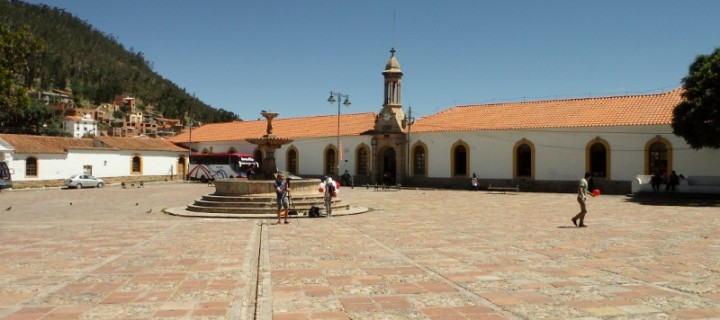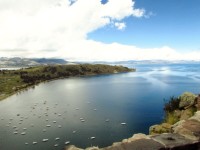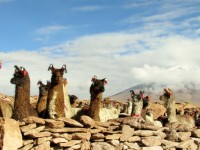Potosi – one of the highest city in the world
As we finished our tour in Uyuni, we headed to Potosi, a city that is full of history but also one of the highest cities in the world, 4,090 meters above sea level!Potosi is also the city of Silver, the city lies at the foot of the Cerro Rico that contains countless amounts of Silver. It was discovered and exploited back in 1545 by the Spanish Empire.
We thought that would be nice to stop by Potosi and learn a bit more about its history. Also, this is the first interesting and touristy city found after Uyuni, only 3 hours away. Exhausted as we were after the tour, a short trip by bus and good night sleep in a cozy hostel was very welcomed. We rapidly knew what to do in the city, which includes a city tour of the up and down hills, the museum de la Moneda and a tour in the cooperative Mines that are still active.
We arrived in Potosi right during the carnival. The carnival in Bolivia is a special time for the locals as it is where religious symbolism and different cultures in the country meet and coexist in songs and dances. It offers both tourists and locals a beautiful spectacle but it is also a time of party and fun ! Carnival in Colombia or Switzerland are not the same but there is a specific times for the procession or the real show. In Bolivia, there is nothing like that. There is a pre-carnival, carnival, and post-carnival that last in total about 3 weeks. During these 3 weeks, people are on the streets at any time of the day, celebrating the carnival with songs and dances but also with water, spray, eggs and all kind of gadget throwing substances at you. That time wasn’t for us our favorite as any time of the day, we could not walk on the street quietly, scared to get wet or dirty. In addition to this, nothing works or is opened. (restaurants, shops or laundry service). Thankfully we arrived in Potosi almost at the end of the carnival as well as for Sucre. We still had 3 days to go where we could basically do nothing…
So, gratefully, some museums were still open and we could improve our general culture, instead of getting wet. We can say thought that Potosi must be a nice place to visit due to its several colonial churches, cute streets and friendly inhabitants. It is a good place also to eat local dishes such as Lomita and excellent quinoa soups!
The Casa Nacional de la Moneda and the history of the silver
Potosi’s history is mainly concentrated to its silver. As mentioned previously, the Spanish empire started to exploit the mines and the city became rapidly the city of “gold” due to the lucrative mines as well as the largest and wealthiest one in south America. The Spanish took advantage of its resources until the Silver production reached its peak around the year 1650. When it started to dry up, they left the country, and the city started to decline slowly into poverty.
To visit the museum “The Casa Nacional de la Moneda” was a good way to understand the exploitation of the silver and its development into coins. Potosi’s mines and its industry used to produce the coins which made Spain rich and laid the foundations of a global currency. The silver was then not only used for the Spanish but on an international level. Nowadays there is no more production of coins but only exportation of the silver.
The mines can be visited but we didn’t go on a tour. It is not something we wanted to experience but we know people that went into there and they could learn more about the work of a miner, the difficulties to be faced and the very hard work. The Lonely Planet warns people that accident occurred in the past and it’s risky to visit the mines.
Visits are held by different companies but the best tours are organized by ex-miners:
– Tours run in the morning or afternoon and last from four to five hours. The standard price is between B$100 and B$150 per person. This price includes a guide, transportation from town and equipment (jacket, helmet, boots and lamp). Read more here.
Beautiful Sucre
Our time in Potosi was short but good ! As the city is very high up in the mountain, we could quite feel the cold. We were happy to head toward Sucre, for a warmer weather and some nice visits. The city is known to be the nicest in Bolivia.
We found a cozy hostel, La Dolce Vita, owned my a French guy and a Swiss girl. The service was good and felt somehow like home. After few exchanges we took possession of a big double room. The first day in Sucre was not the best. The weather was rainy and carnival still going on. People were animated at throwing water at people’s faces from morning to night. The second day was the last day of the carnival, we went on the street to listen to people playing music but the agitation of people and kids was at its maximum. We went back to the hotel.
The third day in Sucre was one of the best as the carnival was over ! Finally.. ! :-)) It is like coming back to civilization. No dirty water on the face, shops are opened, streets are full of locals, people are normal. The day was sunny and warm. What a delight !:-)
There are some couple nice attractions in Sucre which we did the same day:
The local market:
The local market is the best way to meet local people. The older generation wears a specific outfit that consists in a big skirt and open shoes, sandals style. Their hair are two long braids falling in the back linked sometimes together by some decorations. It is very interesting to see such big cultural difference in term of fashion and habits. Bolivian people seem also more shy than any other countries we have visited. They usually don’t try to rip off people.
We took then a tour in this big market where color and good smells were all around. There is the fruits and veggies department as well as the meat and spices department. We bought some good stuff to do a good dinner in the evening 🙂 Well, it has been great to walk around and buy food we like and get to know finally a little bite of the local culture.
The view point:
The view point is a 30 mins walk from the main plaza. Once arrived on the peak, we could admire the view and the impressive Andes in the background. The scenery is amazing and we sat here on the small terrace with a nice cold beer. 🙂
It was worth the small hike but we had for sure to stop a couple of time. Sucre is at 2780 meters high and our breath became very fast short. Bolivia is one the highest countries in South America. So whenever we do a hike, we know we need to take it easy and running is for sure not an option. It is maybe what makes the country peaceful and welcoming. People don’t seem stressed. They take their time. We also have to say that Bolivia has a lot of poverty. Life is apparently not easy for many Bolivians. So the non-stress, joy, parties they have from time to time give a nice touch to their daily life.
The cemetery:
To us, it didn’t sound exciting to visit a cemetery but apparently it was a nice place to see. When we got there the cemetery was unfortunately closed. We could see though a lot of trees nicely shaped, a lot of flowers and cute decoration everywhere. It has nothing to do we our colorless and tasteless cemetery back home!
This attraction was one of the highlights. The park give a small introduction on the dinosaur period living in Bolivia about 65 million years ago. The most interesting part has been the footprints they found right there. Because of the presence of water and a special type of rock back then, the dinosaurs’ footprints have stayed marked into the floor. Years later, with the erosion, many footprints have been discovered making the place one of the largest collections of dinosaur footprints in the world. Unfortunately, the government doesn’t pay much attention to it, and the park is waiting to get funding to protect the marks and keep the area intact. With the wind and the rain, the footprints may be very easily damaged.
Useful information:
Where to stay in Potosi: Eucalyptus hostel, breakfast, central, 228.- BOB/ night double room,88 Linares Street, Ayacucho 3,Potosi.koalabolivia@hotmail.com
Where to stay in Sucre: La Dolce Vita, no breakfast, central, 150 BOB/ night double room, Calle Urcullo No. 342 Sucre, reservation@dolcevitasucre.com
Where to eat in Sucre: at the local market (second floor) for local dishes, and the Condor café for excellent vegetarian dishes, http://www.condorcafe.org
Where to have a drink in Sucre: The Kultur Berlin, hostel and bar. Full of travelers and nice atmosphere, http://kulturberlin.com




























































































